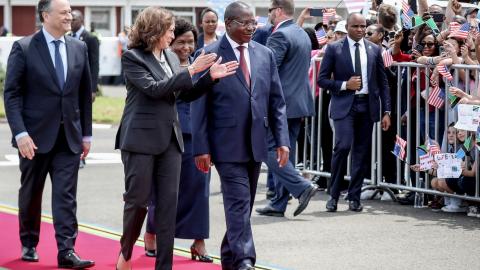Under the Biden administration, the United States seems keen to reengage with Africa. U.S. Secretary of State Antony Blinken traveled to Ethiopia and Niger in March. Later that month, U.S. Vice President Kamala Harris visited Ghana, Tanzania, and Zambia. And U.S. President Joe Biden has announced plans for an official trip to Africa later this year. These trips come as China, India, and the states of the Gulf Cooperation Council (GCC)—Bahrain, Kuwait, Oman, Qatar, Saudi Arabia, and the United Arab Emirates (UAE)—steadily increase their influence across the continent.
This increased attention is in part because it is becoming clearer that Africa has potential to be the site of significant economic expansion. By 2030, around 20 percent of the global population will live in Africa, rising to 25 percent by 2050. Africa’s GDP, currently around $3 trillion, is projected to increase significantly by 2050. Improvements in education, technology, and infrastructure combined with demography to facilitate GDP growth in Asia over the last two decades; Africa could benefit from the same factors in the future.
Africa is also a site of geostrategic competition, where Western governments aim to use political instruments and aid to counter China and Russia. Like Beijing, Washington has hosted its own Africa summits, albeit inconsistently; it also provided $8.5 billion in aid to Sub-Saharan Africa in fiscal year 2021, up from previous funding levels. But these efforts—which focus on health, social development, and democratic governance—have met with limited success. By contrast, China, India, and the Gulf countries have invested in infrastructure improvement, manufacturing, mining, and farming. Their combination of diplomacy, aid, investment, and trade has gained more traction—as reflected by trade volumes. Their example shows how the United States could better reengage with Africa by sharpening its economic gameplan.
Between 2010 and 2016, more than 320 foreign embassies opened across Africa—part of what was dubbed a “new scramble” for the continent. These included diplomatic missions from Kuwait, Qatar, Saudi Arabia, Turkey, and the UAE. In 2019, India announced it would open 18 missions in Africa. During this time, the United States did not significantly expand its diplomatic presence on the continent. In fact, U.S. embassies in Africa have faced a staff crunch, possibly because of Washington’s military and diplomatic preoccupations elsewhere.
Although U.S. foreign-policy discourse has not focused on the developments in Africa, they have great significance for policymakers in Washington. China’s focus on Africa has captured some U.S. attention, as has India’s growing interest in the continent. But the role of the Gulf countries in Africa remains understudied. African countries increasingly intersect with Gulf-Asia relations, which have acquired a strategic dimension in recent years. Furthermore, some Asian and Gulf countries are collaborating in so-called “minilateral” development projects in Africa, offering a potential policy model for the United States. The factors that furthered Gulf-Asia ties may facilitate Gulf-Africa relations too, including cooperation on agriculture, energy security, infrastructure, and consumer and technology markets.
Africa is fast becoming a laboratory for the Gulf countries, as well as China and India, to test new economic, diplomatic, and security arrangements. And just as regional trade within Asia gathered momentum in recent decades, the African Continental Free Trade Area, which began operating in 2021, could enhance trade among African neighbors. Countries in the Gulf and Asia can share their successful experiences in intra-regional trade—and then tap the benefits of cross-regional investment and other economic opportunities in Africa. The Gulf countries have substantial financial liquidity and are looking to expand their portfolios in emerging markets.
China, India, Saudi Arabia, and the UAE are currently among the most influential partners in Africa. In 2021, China’s trade with Africa totaled $254 billion (nearly 10 percent of Africa’s total GDP); India’s trade with Africa totaled almost $90 billion. (As a bloc, the European Union was Africa’s largest trading partner that year, at $300 billion.) Meanwhile, U.S.-Africa trade dropped from $142 billion in 2008 to $64 billion in 2021.
The UAE is the largest Gulf trader and investor in Africa, having increased its trade with the continent significantly since 2005. Between 2012 and 2022, it invested around 60 percent of the $102 billion GCC investments on the continent. UAE-Zimbabwe trade increased by 300 percent between 2018 and 2021. Dubai-based ports operator DP World has committed, together with Britain’s CDC Group, to jointly invest $1.7 billion in African ports; and since 2020 Emirates Global Aluminum has been shipping millions of metric tons of bauxite ore from its $1.4 billion mine in Guinea. The UAE appears to be diversifying its economic relationship with African countries, winning influence and creating opportunities for future economic, political, and security ties.
In addition to promoting diplomatic and economic interests at the bilateral level, countries in the Gulf and in Asia are engaging in minilateral or trilateral arrangements to design and fund development projects in Africa. In 2019, India announced it would build a cancer hospital in Kenya in collaboration with Japan and, with the UAE, an information and communication technology center in Ethiopia. Last year, Israel and the UAE signed up to jointly fund a $150 million health-care project in Ghana.
African leaders have expressed that the experiences of countries beyond the West may have more lessons for African countries, given their similar socioeconomic and political structures. After all, Africa shares a recent postcolonial history with Asia and the Gulf countries that makes cooperation easier. Solutions to problems in Africa may also be more likely to resemble those in Asia and the Gulf countries. For example, India’s cheap digital payment system is seen as both replicable and scalable in other developing countries, making it more attractive than expensive Western solutions. Similarly, China and the UAE are helping Africa develop its renewable energy sector, and Saudi Arabia has invested heavily in the electricity and water sectors.
In recent years, Gulf countries have increasingly linked their trade, investment, and humanitarian aid in Africa with diplomacy and security issues. In 2007, Saudi Arabia hosted the signing of the deal between Sudan and Chad to stabilize Darfur; the 2018 Eritrea-Ethiopia peace deal was also the result of Saudi-UAE mediation. Saudi Arabia and the UAE pledged nearly $150 million to a counterterrorism force in West Africa’s Sahel region in 2017. Gulf countries have also recruited African forces to support military operations in the Middle East and trained and equipped Somali troops to fight Islamist insurgency.
Although the sentiment behind it is understandable, the U.S. strategy of promoting democratic governance in Africa may not be the best way to further Washington’s goal of positioning itself as an alternative to Beijing and Moscow’s growing influence on the continent. Gulf-Asia relations with Africa have grown exponentially—at the cost of the West—in large part because they had fewer political strings attached. Enhanced economic engagement would be more effective than lectures on political philosophy in the United States. African leaders have said nearly as much: At the U.S.-Africa summit in Washington last year, African diplomats requested that economic issues be the priority.
To balance its values and interests, the United States could join its friends and partners in the Gulf and Asia and develop minilateral partnerships in Africa. One vehicle for such engagement could be the I2U2 grouping of India, Israel, the UAE, and the United States, already heralded as a “partnership for the future.” The United States could also consider reducing unconditional aid and substituting it with results-oriented development support, along with pursuing unconditional and innovative mechanisms of economic engagement. Washington could offer an economic cooperation agenda that does not clash with Africa’s current investment and trade partners.
African countries are more than bit players or spheres of influence. In an increasingly multipolar world, the United States would do better to create a balance of interests mechanism in Africa, working alongside expanding Gulf-Asia-Africa ties.




















